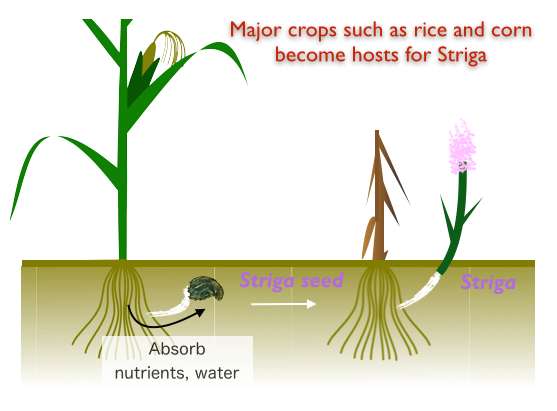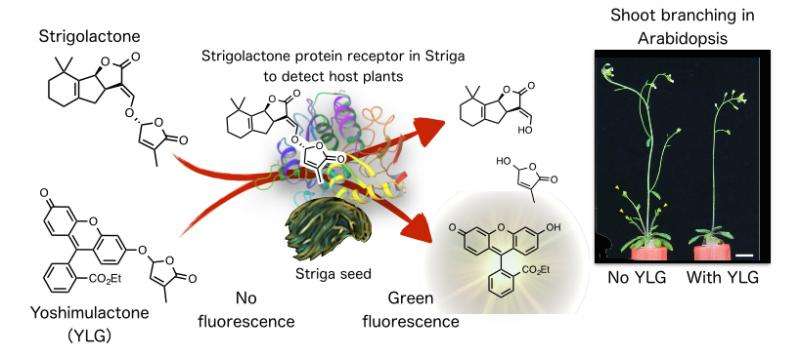Fluorescent turn-on probe identifies the 'wake-up protein' in witchweed seeds

A molecular approach has been used to identify the protein responsible for germination of Striga seeds through visualization by green fluorescence. Striga, a parasitic plant known as witchweed has seriously affected millions of hectares of crop fields in Africa that poses a major threat to food security. Nevertheless, the exact mechanism on how Striga seeds detect host crops has not been fully clear up to now. In a new study reported in Science, ITbM's chemists and biologists have come together to develop a new visualizing molecule to examine the process of Striga germination. The outcome of this study is expected to accelerate research to control Striga growth and to save crop losses worth of billions of U.S. dollars every year.
Nagoya, Japan - Striga is a parasitic plant that mainly affects parts of Africa. Despite its beautiful purple-pink flowering, Striga is a major threat for food crops, such as rice and corn as it infests the host crop plant through its roots by depriving them of their nutrients and water. The host plant eventually withers, leading to yield losses in approximately 40 million hectares of land, worth over 10 billion U.S. dollars, which affects over 100 million people. Yet, the full mechanism on how Striga detects the presence of the host plants has been unclear up to now and efforts are being made to develop new methods to combat Striga.
Striga is known to detect host crop plants from a class of plant hormones called strigolactones released by plants. Strigolactones are known to be responsible for controlling shoot branching and to attract mycorrhizal fungi present in the soil, which supplies the plant with nutrients. Plants increase strigolactone synthesis when they are in a malnutrition state to restrain their growth and gain nutrients from fungi. However, strigolactones also trigger Striga germination, which actually leads to further deprivation of nutrients from infestation instead of escaping malnutrition.
"I figured that there must be a protein receptor in Striga that can detect minute amounts of strigolactone produced by the host plant," says Yuichiro Tsuchiya, a plant biologist at the Institute of Transformative Bio-Molecules (ITbM) at Nagoya University. Since Striga usually grows upon parasitizing to a host plant, the genetic intractability of Striga has been the main barrier for identifying its germination mechanism. "I was screening commercially available strigolactone derivatives with hope to find molecules that can identify the strigolactone receptor responsible for germination in Striga." Striga is known to wither and die if they are unable to find a host after germination. Therefore, molecules that can artificially induce Striga germination would be a promising agrochemical to control Striga germination and thus prevent parasitism towards crops.
Tsuchiya joined Nagoya University in 2013 and coincidently came across graduate student Masahiko Yoshimura, a synthetic chemist, in a communal analytical laboratory. Upon passing each other several times, Tsuchiya started to talk about his research with Yoshimura, who quickly expressed an interest in Tsuchiya's research. Together with Shinya Hagihara, an associate professor at ITbM who is also a chemist, Yoshimura designed a strigolactone-like molecule, which he synthesized in two days.

"I was really surprised how quickly Yoshimura-kun synthesized the probe molecule," says Tsuchiya. "This is obviously a result of ITbM's extensive collaborative environment between chemistry and biology."
"We named the molecule 'Yoshimulactone (YLG)', which is designed to generate green fluorescence upon reacting and being decomposed by protein receptors detecting strigolactones in Striga," says Hagihara.
Yoshimura first treated a model Arabidopsis plant with Yoshimulactone and found that it controls shoot branching in the same way as strigolactones does, thus indicating that it exhibits a similar bioactivity. When Striga seeds were treated with Yoshimulactone, the team observed seed germination along with green fluorescence.
"Our investigations show that Striga seeds possess strigolactone protein receptors," say Tsuchiya and Hagihara. "We were also able to identify the actual proteins responsible for seed germination in Striga with the observation of green fluorescence, which appeared upon treatment with Yoshimulactone."
Further analysis of Striga seeds with Yoshimulactone revealed that Striga's parasitizing mechanism is likely to work by initial recognition of a nearby host plant by detection of strigolactones and their derivatives. This point of recognition eventually becomes the root tip of Striga and triggers the awakening of the entire Striga seed, which then stimulates root growth towards the host plant.
"To be honest, I had not known about Striga before starting this research and did not have a clue that such a pretty pink flowering plant could have such a devastating effect towards crops," says Yoshimura. "I had some knowledge about fluorescent molecules, which helped me to design the probe molecules. Although I didn't have a biology background, I really enjoyed conducting the experiments with plants and to discover a key component that may shed light to solving the food insecurity caused by Striga."
The main reason for why the Striga problem has been so difficult to overcome arises from Striga's unique survival strategy. Striga seeds are small in size (about 0.3 mm) and are easily scattered by the wind. In addition, Striga seeds remain dormant in the soil for decades until it finds a host plant. Upon sensing the host plant in close proximity, the parasitic seeds germinate and infest the host plant. After absorbing the nutrients and water from the host plant, the Striga plant flowers and generates more seeds. This snowball effect makes it extremely difficult to exterminate Striga once a crop field is affected by it, and may lead to total crop failure in severe cases.
"My interest towards Striga emerged since 2004, when I was studying plant germination through screening strigolactone derivatives in Canada," says Tsuchiya. "I was fortunate to be able to solve the long sought mystery of strigolactone receptors in Striga by the molecules synthesized at ITbM. I hope to go to Africa to save Striga-affected crop fields using our new molecular approach," he continues.
ITbM's research team is currently working on developing new molecules to control Striga germination and prevent parasitism towards crop plants.
More information: "Probing strigolactone receptors in Striga hermonthica with fluorescence" by Yuichiro Tsuchiya, Masahiko Yoshimura, Yoshikatsu Sato, Keiko Kuwata, Shigeo Toh, Duncan Holbrook-Smith, Hua Zhang, Peter McCourt, Kenichiro Itami, Toshinori Kinoshita and Shinya Hagihara is published online on August 21, 2015 in Science, 349, 6520, 864-868. DOI: 10.1126/science.aab3831
Journal information: Science




















